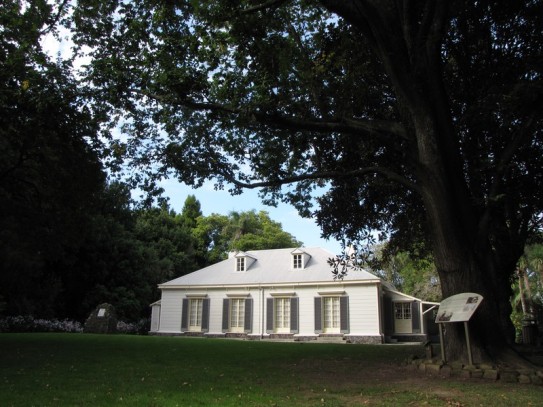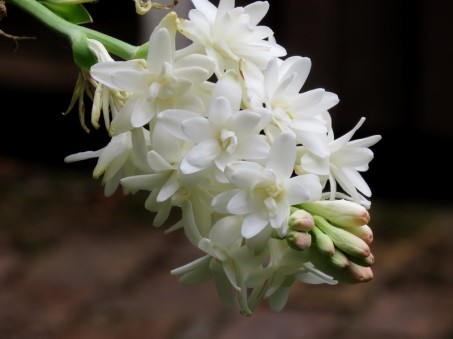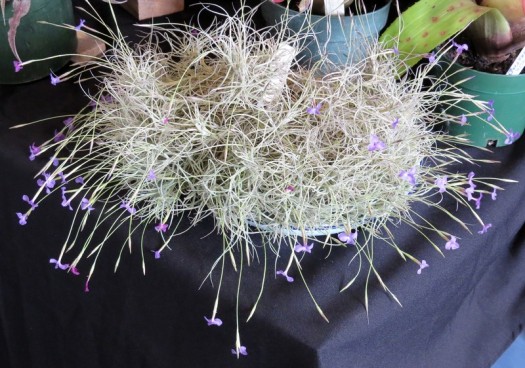The Elms mission house is one of the most important colonial buildings in New Zealand, second only to the Treaty House at Waitangi – but it’s not only the building that tells a story, the garden does too.
Unfortunately, the garden isn’t obviously exciting, although there are good reasons for that. As the late historian and long-time member of The Elms Trust Jinty Rorke would ask, “which garden do you want to see?” – the Browns’ mission station garden of the 19th century, the early 20th century garden of the Maxwell women, or the late 20th century garden of Duff Maxwell. Read more about the historic property.
“And,” Jinty would say, “the trees have kept on growing. Even the garden that the Browns had couldn’t be replicated now because the trees are all a century older.”

The Elms mission house from the seaward side – the replanted elm is on the right and on the left near the house is a cairn marking the spot of the original raupo hut. Photo: Sandra Simpson
The towering English elm Ulmus procera on the seward lawn is a sucker from one of the trees that gave the property its name in 1873. The last of the original elms was felled in 1952, with this tree planted in 1945. The oldest tree on the property is however, the oak at the corner of the north lawn – grown from an acorn brought from England in 1829 by the Reverend Alfred Nesbit Brown (1803-84) and transplanted here in 1838.

The Reverend Brown’s oak dates back to an 1829 acorn. Photo: Sandra Simpson
Dr James Beattie, associate professor at Waikato University’s History Department, and Margie Smith, who completed a directed study of The Elms for a Bachelor of Arts degree under the guidance of Dr Beattie, say mission gardens were important repositories of meaning and sources of identity – and were often used to introduce Maori to European agriculture as a prelude to introducing them to European religion.
The Elms was home to Mr Brown, his first wife Charlotte (1795/6-1855) and second wife Christina. They, and others such as the Christian Mission Society catechist John Flatt, all played a part in establishing the garden from the mid-1830s.
“Along with whaling stations, missionary gardens had some of the earliest and most important introductions of Eurasian species into New Zealand,” Dr Beattie says.
The first plants to go in at The Elms from 1836 were fruit trees – the house we see today wasn’t finished until 1847 – and from Mr Brown’s permanent arrival in 1838 he threw himself into gardening, a survival skill as much as a creative one, and quickly created a nursery, with seeds, cuttings and plants seemingly freely exchanged between mission stations and other settlers. Figs, grapes, peaches and roses all made their way around the country via the mission stations (as did grass seed – ryegrass seed, for instance, arrived in Hawke’s Bay in 1834 or 1835 from the Bay of Islands).

Fruit trees are still part of the garden. Photo: Sandra Simpson
Responsible for preserving the produce, whether by bottling or jam-making, the women probably worked in the gardens as well.
There were flowers, planted in a fashionable round bed at the front of the house, as well as exotic trees and shrubs sourced from around the world, and including the many elms that in 1873 saw the property renamed. The Browns also brought with them New Zealand’s first piano.
May 20, 1842: 114 bags of potatoes brought by the Natives from Maungatapu in payment for testaments supplied to them some months since. – Brown’s diary
Believe it or not (and perhaps Mrs Brown didn’t) the family lived in a raupo hut, a common building material for Maori and something like a bulrush, as first a free-standing library was built in 1839 to house Mr Brown’s many books, then a chapel for his converted natives, European helpers and frequent visitors to the mission … and then a timber home for himself and his family. The mission house was finished in 1847.
A diary entry by young Celia Brown, the daughter of Alfred and Charlotte, in 1848 records bulbs, aloes, cabbage roses and sweet peas, while new seeds had arrived from a friend – passion fruit, pomegranate, scarlet acacia, Chinese pink, American daisy, lavender, cockscombs and princess feathers.
“More eloquent than words, the garden remains as a statement of the accumulation of many centuries of history to which the Brown years contributed an important and significant part,” Dr Beattie says.

The cones of Araucaria bidwillii, or bunya pune, are so heavy (up to 18kg) that the tree is taped off when they begin to ripen and fall. Photo: Sandra Simpson
There have been three or four distinct gardens – that started by Mr Brown in the mid-1830s; that dating from about 1887 when Euphemia Maxwell, sister and heir to Mr Brown’s second wife, and her daughters Alice and Edith were in residence; the native New Zealand theme from about 1919; and that dating from the residency of Duff Maxwell, nephew of Alice and Edith, who lived at The Elms from 1949 to 1992 and who added many of the more unusual plants.
Euphemia inherited the property from her sister on the condition that she live at The Elms and that it would pass to Alice and this was honoured. Read the biography of Alice Heron Maxwell. Alice and Edith sold flowers from the garden to raise money for troops going to World War 1 and, after their mother’s death, Alice began to plant native tree seedlings she had obtained from the East Coast, changing the character of the garden.
Jinty, who first visited the garden in 1976 when it was “quite different”, tried to bring a sense of order to the garden as per a landscape plan prepared in 2004 by Richard Hart.
“For a long time the council has cared for the grounds and the reality is that it’s faster and easier to mow grass than it is to prune roses or have flower beds,” she said. “But we know from visitor comments that people would like to see more colour.”

Waxeyes enjoy magnolia buds. Photo: Sandra Simpson
The garden’s age, particularly the age and size of some of the trees, makes re-creation a moot point.
“Early photos show a circular shell walk around the front lawn but it would be difficult to reinstate because of the size of the trees,” Jinty said. “And because of the size of the trees, this has now become a shaded garden.
“We can’t go back to Brown’s time because the trees would only have been a metre tall – but the structure we enjoy today is his legacy.”
Some garden history:
The original site was staked out in 1834 with the Browns taking up permanent residence in 1838, the same year Brown purchased from Maori 12.5ha, an area that has been greatly reduced by succeeding generations. Today, The Elms sits on a generously sized urban section.
January 27, 1837 Brown recorded in his diary that My lads commenced raising the fencing around my garden.
In 1841 a visitor records … the Church mission-station surrounded with gardens and a planted shrubbery of acacias, ricinus [castor-oil plant] and peaches which was almost the only vegetation in the shape of trees we saw, as for several miles round the station there is no wood.
Mr Brown introduced wheat into the area and taught Maori how to grow it and mill it.
In 1857 a visitor described yellow Cape jasmine reaching the height of a tree, 3.6m-high rose hedges, and a home orchard including apples and peaches.
Hollyhock seed obtained from Buckingham Palace was planted in the 1930s and re-used for many years.
The garden in front of the library was destroyed by fire in the 1950s.

The original gate to the property for visitors arriving by sea. Thanks to reclamation, the harbour is now some distance from The Elms, but still visible. The stump in the foreground was one of the pair of Norfolk Island pines planted at the gate (the tree was removed after being struck by lightning). Norfolk Island pines (Araucaria heterophylla) were favoured by missionaries for the Christian cross, renewed in each year’s new growth. Photo: Sandra Simpson
Most of this article was first published in the Bay of Plenty Times and appears here with permission.















